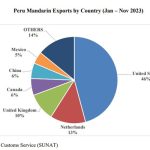FAS Lima forecasts Peruvian mandarin/tangerine production of 545,000 metric tons (MT) in the year of marketing (MY) 2023/24 (March 2024 through February 2025) in a decline of 1 percent over the year prior. The lower yields caused by higher than average temperatures as well as other negative weather patterns will affect exports and production. The consumption in the US of mandarins and tangerines is expected to be 318,000 by the MY 2023/2024. That’s a 2 percent drop from last year’s. Peruvian mandarin and tangerine exports are expected to be at around 200 MT. In the United States will likely remain the country’s largest exporter.
ProductionMandarin production in Peru is predicted to be 545,000 tonnes (MT) during the this year’s marketing calendar year (MY) 2023/24 (March 2024 until February 2025) which is a drop by one percent from the last year. Anomalies in the weather that are associated with this El Nino phenomenon will likely affect the productivity of the next year particularly among the early-season varieties. As per the Peruvian government’s El Nino monitoring system, the warm weather is likely to continue, and there are forecasts of El Nino’s strength may range from strong (49 percent) or moderate (47 percent). El Nino impacts could also be detrimental to the mandarin/tangerine industry due to heavy rain and the possibility of losing crop land as a result of flooding.
Weather conditions that are unfavorable, a lot of precipitation prior to harvest as well as temperatures that were above average delayed the production during the current market year. Peru had an unusually warm winter (4-5 over the average) which affected the production of varieties that were early in development, such as Primosoles, Clementines, and Satsumas. Mandarins require cooler weather during the latter stages of their development to attain the required color that is required to export high quality. The expectations for late varieties (Tangelo, Tango, Orri as well as W. Murcott) were extremely high however, bad weather conditions persisted and some varieties that were late performed lower than their average performance as well. The harvest time in Peru runs from March through October. However, the seasonality of the MY 2022/2023 season was impacted by a delays in the start of the season, which led to the availability to be less fruits. Conditions in the weather were the major factor behind the 10% reduction in MY 2022/2023’s exports.
The total fresh exports for MY 2022/23 decreased by 10 percent from last year. They dropped by 220,000 MT to 200 – 200,000 MT. For MY 2015/16, Peru exported 112,000 MT and has seen steady growth, almost doubled their exports in the last year.
Click here to read the entire report.
Source: apps.fas.usda.gov
